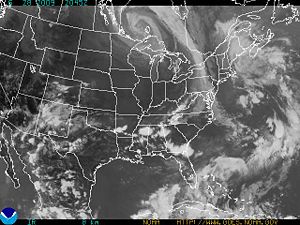Geostationary Operational Environmental Satellite: Difference between revisions
imported>Howard C. Berkowitz No edit summary |
imported>Howard C. Berkowitz No edit summary |
||
| Line 5: | Line 5: | ||
They also have a critical role in the [[Global Maritime Distress and Safety System]], carrying some of the [[transponder]]s of the multi-satellite [[COSPAS-SARSAT]] system that receives and relays signals from [[emergency position indicating radio beacon]]s (EPIRB). These satellites also broadcast a precision time reference that may be available when a [[GPS]] signal is not. | They also have a critical role in the [[Global Maritime Distress and Safety System]], carrying some of the [[transponder]]s of the multi-satellite [[COSPAS-SARSAT]] system that receives and relays signals from [[emergency position indicating radio beacon]]s (EPIRB). These satellites also broadcast a precision time reference that may be available when a [[GPS]] signal is not. | ||
==Imager== | |||
[[Image:GOES Eastern US IR imaging.JPG|left|thumb|300px|Infrared image of eastern US, superimposed boundaries]] | |||
While GOES produces images that are understandable to the human eye, they are not taken with an instrument corresponding to a [[camera]], but with a multispectral radiometer that gives a point-by-point luminosity from which images can be constructed. It operates in one visual and four infrared wavelengths, one optimized for moisture sampling. | |||
The instrument uses a "a servo driven, two-axis gimbaled mirror scanning system in conjunction with a Cassegrain telescope, the Imager's multispectral channels can simultaneously sweep an 8-kilometer (5 statute mile) north-to-south swath along an east-to-west/west-to-east path, at a rate of 20 degrees (optical) east-west per second. This translates into being able to scan a 3000 by 3000 km (1864 by 1864 miles) "box" centered over the United States in just 41 seconds. The actual scanning sequence takes places by sweeping in an East-West direction, stepping in the North-South direction, than sweeping back in a West-East direction, stepping North-South, sweeping East-West, and so on."<ref>{{citation | |||
| title = GOES Imager Instrument | |||
| publisher = National Atmospheric and Oceanographic Administration | |||
| url = http://noaasis.noaa.gov/NOAASIS/ml/imager.html}}</ref> | |||
==References== | |||
{{reflist}} | |||
Revision as of 16:54, 28 June 2009
Geostationary Operational Environmental Satellites (GOES) are optimized for long-term observation and pattern/signature recognition of phenomena in Earth's atmosphere and on Earth. Their geosynchronous orbits allow them to scan the same field of view for long periods of time.
One obvious trigger event is detecting severe storms and forest fires. In addition, they help in rainfall and snow cover estimation, which can predict floods and winter storms. They track the movement of sea and lake ice.
They also have a critical role in the Global Maritime Distress and Safety System, carrying some of the transponders of the multi-satellite COSPAS-SARSAT system that receives and relays signals from emergency position indicating radio beacons (EPIRB). These satellites also broadcast a precision time reference that may be available when a GPS signal is not.
Imager
While GOES produces images that are understandable to the human eye, they are not taken with an instrument corresponding to a camera, but with a multispectral radiometer that gives a point-by-point luminosity from which images can be constructed. It operates in one visual and four infrared wavelengths, one optimized for moisture sampling.
The instrument uses a "a servo driven, two-axis gimbaled mirror scanning system in conjunction with a Cassegrain telescope, the Imager's multispectral channels can simultaneously sweep an 8-kilometer (5 statute mile) north-to-south swath along an east-to-west/west-to-east path, at a rate of 20 degrees (optical) east-west per second. This translates into being able to scan a 3000 by 3000 km (1864 by 1864 miles) "box" centered over the United States in just 41 seconds. The actual scanning sequence takes places by sweeping in an East-West direction, stepping in the North-South direction, than sweeping back in a West-East direction, stepping North-South, sweeping East-West, and so on."[1]
References
- ↑ GOES Imager Instrument, National Atmospheric and Oceanographic Administration
